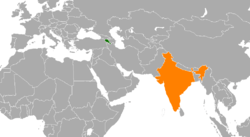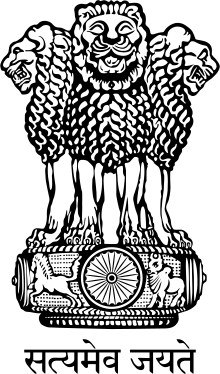Armenia–India relations
Armenia–India relations refers to international relations between Armenia and India.
 | |
Armenia |
India |
|---|---|
Early history
Armenians are believed to have come to India, when some Armenians joined the auxiliary elements of the forces under the command of Alexander the Great when he crossed Armenia en route to India. The earliest documented references to the mutual relationship of Armenians and Indians are found in Cyropaedia (Persian Expedition), an ancient Greek work by Xenophon (430 BC – 355 BC). These references indicate that several Armenians traveled to India, and they were well aware of land routes to reach India, as also the general and political geography, socio-cultural milieu, and economic life of the Indian subcontinent.[1]
According to Zenob Glak, one of the first disciples of Gregory the Illuminator, the patron saint of Armenia, at least 7 Hindu cities were established in Armenia sometime around 349 B.C. The institution of Nakharar was founded by Hindu Kings from even earlier. Zenob wrote that the colony was established by two Indian princes from Ujjain who had taken refuge in Armenia.[2] They worshipped Ganesha and their descendants multiplied and ruled over a large part of Armenia. Under the pagan rulers, the Hindu cities flourished until the dawn of Christianity in Armenia in 301 A.D.[3] The ruins of the Saint Karapet Monastery, now in Turkey, stands at the site of the Hindu temples.[4][5] Literary evidence indicates the existence of Indian settlements in Armenia as early as 149 BC. The settlements were established in Taron, Greater Armenia (roughly corresponding to the Muş Province of present-day Turkey) by two Indian Princes, their families and retinue, on land provided by the then rulers of Armenia.[6] An archive directory (published 1956) in Delhi states that Armenian merchant-cum-diplomat Thomas of Cana arrived on the Malabar Coast in 780 AD using the overland route. Thomas was an affluent merchant dealing chiefly in spices and muslins. He was also instrumental in obtaining a decree, inscribed on a copperplate, from the Chera Dynasty, which conferred several commercial, social and religious privileges for the regional Saint Thomas Christians. In current local references, Thomas of Cana is known as Knayi Thomman or Kanaj Tomma, meaning "Thomas the merchant". Armenians had trade relations with several parts of India, and by the 7th century a few Armenian settlements had appeared in the present-day state of Kerala on the Malabar Coast. Armenians controlled a large part of the international trade of the area, particularly in precious stones and quality fabrics.[7]
Medieval history
Mughal emperor Akbar (1556–1605), invited Armenians to settle in Agra in the 16th century,[8] and by the middle of the 19th century, Agra had a sizeable Armenian population. Armenian traders visited Agra during the Mughal Empire. Akbar granted Armenians several privileges, considerable religious freedom and the opportunities to work for the government. Mariam Zamani Begum, one of Akbar's wives, was an Armenian.[9] By an imperial decree, Armenian merchants were exempted from paying taxes on the merchandise imported and exported by them, and they were also allowed to move around in the areas of the Mughal Empire where entry of foreigners was otherwise prohibited. In 1562, an Armenian Church was constructed in Agra. From the 16th century onwards, the Armenians (mostly from Persia) formed an important trading community in Surat, the most active Indian port of that period, located on the western coast of India. The port city of Surat used to have regular sea borne to and fro traffic of merchant vessels from Basra (in present-day Iraq) and Bandar Abbas (in present-day Iran). Armenians built two Churches and a cemetery in Surat. A tombstone in the city, dating back to 1579, bears Armenian inscriptions. The second Church was built in 1778 and was dedicated to Mary. An Armenian language manuscript written in 1678, currently preserved in Saltikov-Shchedrin Library, St. Petersburg, has an account of a permanent colony of Armenians in Surat. The Armenians settled in Chinsurah, near Calcutta, West Bengal, and in 1697 built a Church there. This is the second oldest Church in Bengal and is still in well preserved on account of the care of the Calcutta Armenian Church Committee.
The Armenian towns of Artashat, Metsbin and Dvin became important centres for barter trade with India by the Middle Ages. India exported stones, herbs and textiles to Armenia, and imported hides and dyes. The Armenian community in India grew in size and wealth throughout the 17th century. Armenians also held varying relationships with the East India Company. Armenians made some contributions in the areas of artisanship including gun-making and printing. Many Armenians in Calcutta were engaged in the legal profession as they were comparatively highly educated.[9]
The Holy Church of Nazareth, the oldest and largest Armenian church in Calcutta, was built in 1707. The Church was repaired and embellished in 1734. The 250th anniversary of the Holy Church of Nazareth was celebrated on 25 November 1957. The Armenian College and Philanthropic Academy is located in Calcutta. The Armenian language journal Azdarar, first published in Madras in 1794, was the first Armenian journal to be published anywhere in the world. In 1994, Armenia issued a special postage stamp to commemorate the 200th anniversary of Azdarar. In 1773, Shahamir Shahamirian, an Armenian nationalist in Madras, published his vision of a future Armenian nation, which Armenians consider to be an attempt to draft the first ever Constitution of an independent Armenia.[9]
Modern history
Indian classical singer Gohar Jaan, who in 1902 became the first person to be recorded on a gramophone, was of Armenian descent. Following India's independence on 15 August 1947, most of the Armenian community in India migrated to Australia, the United States and other countries. The remaining Armenian community in India is primarily concentrated in Calcutta, with a few also residing in Mumbai, Delhi, Agra and Chennai. All of these cities have Armenian churches and cemeteries. Marriages between Indians and Armenians has resulted in a small population of Indo-Armenians.[9]
Indian President Sarvepalli Radhakrishnan visited the Armenian Soviet Socialist Republic in September 1964, and Prime Minister Indira Gandhi visited in June 1976.[9]
India recognized Armenia on 26 December 1991, three months after it declared independence from the Soviet Union. Diplomatic relations between India and Armenia were established on 31 August 1992. India opened its embassy in Yerevan on 1 March 1999. Armenia, which had opened an honorary consulate in April 1994, established its embassy in New Delhi in October 1999.
Armenian Presidents Levon Ter-Petrosyan and Robert Kocharyan visited India in 1995 and 2003 respectively.
Reception to Armenian Catholicos in Kochi
Karekin II, Supreme Patriarch and Catholicos of All Armenians, who reached here on Wednesday for his first pontifical visit to the State, was accorded a grand reception at the Cochin International Airport by leaders of the Malankara Orthodox Syrian Church.
The Catholicos, who arrived at the airport on an Emirates flight at 8.40 a.m. along with a seven-member team, was received by Catholicos-designate Paulos Mar Milithios, Metropolitan of Kochi Zacharias Mar Antonios, Church trustee Fr. Johns Konat, Ambassador of Armenia in India and other church leaders.
Addressing a large media contingent at the airport, the Catholicos expressed his happiness in getting an opportunity to make his first ever fraternal visit to the State on the invitation of the Orthodox Church.
“We have come here on a fraternal visit to the State to offer our prayers together in unity to God for the peace of the world and for the brotherhood of all States and nations,” he said.
The Armenian Catholicos said this opportunity would be used to further enforce the good relationship between the Orthodox Church in India and Armenian churches. Karekin II said they would offer prayers together in search of a solution to all challenges that human kind had been facing.
During his four-day visit to the State till Saturday, the Catholicos will attend various functions in Eranakulam, Kottayam and Pathanamthitta districts including a public reception in Kottayam on Thursday evening. The Catholicos will visit the Orthodox Theological Seminary in Kottayam and open a recording studio of the Sruthy Music School there.
The Armenian Catholicos will visit the Armenian communities living in Kolkata and Chennai.
Later, the Catholicos left for Kottayam by road accompanied by scores of metropolitans, church functionaries and devotees.
The Armenian Catholicos is the central religious authority for the Armenian Orthodox population in Armenia and for the Armenian Orthodox communities worldwide.
In 2019, the relations began to improve further after Narendra Modi met with Armenian prime minister Nikol Pashinyan in the sidelines of the 2019 UNGA summit in New York. The move was taken in order to counter Pakistan's ties with Turkey.
Armenian community in India
See also
- Armenian Church, Chennai
- Armenian Church of St. John the Baptist
- Armenian cemetery in Hyderabad
- India-Russia relations
- Pakistan-Armenia relations
- Armenians in India
References
- India and Armenia Partners - Embassy of India in Armenia [ENG] Archived 2007-03-20 at the Wayback Machine
- India-Eurasia, the way ahead: with special focus on Caucasus, Centre for Research in Rural and Industrial Development, Centre for Caucasian Study Centre for Research in Rural and Industrial Development, 2008 p. 205
- Memoir of a Hindu Colony in Ancient Armenia, by Johannes Avdall, Esq., M. A. S., Journal of the Asiatic Society of Bengal, Volume V, Issue 54, 1836, II.
- Ghrejyan, Lousine (2010). "Երկվորյակների առասպելի ելակետային արժեքը հայ վիպական հուշարձանների հորինվածքում [Initial Significance of the Myth of Twins in the Composition of Armenian Epic Monuments]". Patma-Banasirakan Handes (in Armenian) (2): 178–192.CS1 maint: ref=harv (link)
- Hacikyan, Agop Jack; Basmajian, Gabriel; Franchuk, Edward S.; Ouzounian, Nourhan (2002). "Zenob Glak". The Heritage of Armenian Literature: From the sixth to the eighteenth century. Detroit: Wayne State University Press. pp. 100–101. ISBN 9780814330234.
- "Bilateral Brief on India- Armenia Relations". www.indianembassy.am. Archived from the original on 6 July 2016. Retrieved 16 May 2016.
- Anusha Parthasarathy (30 July 2013). "Merchants on a mission". The Hindu. Chennai, India. Retrieved 25 December 2013.
- Julfa v. Armenians in India
- "ARMENIA-INDIA BILATERAL RELATIONS". www.indianembassy.am. Archived from the original on 28 October 2011. Retrieved 16 May 2016.

